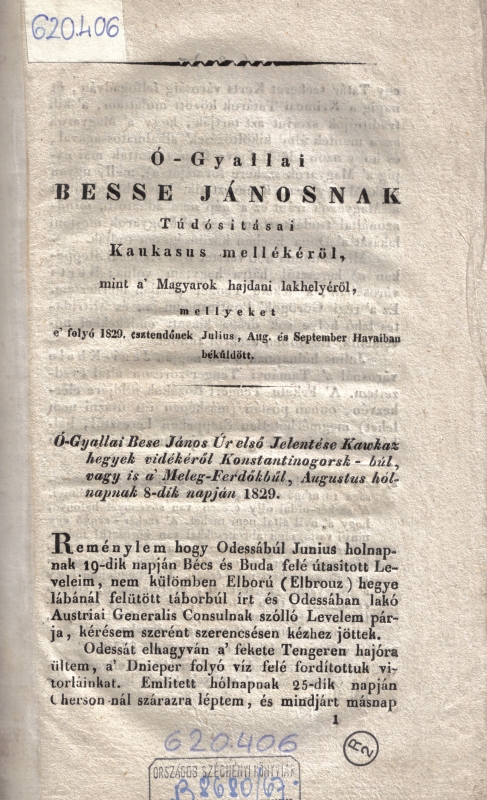
Hungarians in the Caucasus – exhibition
The spring feature exhibition of National Széchényi Library deals with a highly interesting and little known field of Hungarian homeland research, i.e. with the issue of the homeland of the Hungarians in the Caucasus. In the 19th century, it was a generally held view that some remaining ancient Hungarians could still be found in the valleys of the Caucasus. Based on this idea, several ethnic units of the region were considered to be identical with the Hungarian, or at least to be the nearest relatives of the Hungarians. In 1825, for example, one of the Hungarian newspapers came out with the following sensational news: “In the neighborhood of the ‘Caucasus mountains’, to the extension of 300 miles, more than seven million people, mixed with Muslims, Persians, Mongols and other nations, speak Hungarian.” A lot of regions in the Caucasus had been identified as the most ancient dwelling places of the Hungarians. At the same time, a number of etymologic theories were published which all suggested that the majority of local geographical names and aristocratic family names had been of Hungarian origin or had some Hungarian relations. Just to mention a few examples, the Mount Elbrus resembling the Hungarian word Elborulsz (You’re falling); the Mount Ararat resembling Ár-ár-állt (Pricker-pricker-stood); Georgian aristocratic family Zicsianov resembling the Hungarian Zichy family; Georgian town Gori resembling the Hungarian Gori family, etc.
 During the 19th century, a number of expeditions had been launched to search for the Hungarians in the Caucasus. In 1819, János Orlay and Gergely Jaksics went on a research expedition and following that, several Hungarian homeland researchers explored the region including, among others, József Rencz, János Ógyallai Besse, Count Jenő Zichy or Lajos Szádeczky-Kardoss. Simultaneously with the expeditions, Hungarian scholars started a stream of debates on the issue of the Hungarian homeland in the Caucasus. As a result of this, a large number of monographs, articles and studies had been written and a Caucasian-Hungarian dictionary was also published. The theory permeated period public speech and it had a great influence on historical consciousness, too. This is best shown in an epic poem written by Hungarian poet Mihály Vörösmarty, entitled “Magyarvár” (Hungarian Castle), 1828, the scene of which is the Castle of Magyari standing on the bank of Caucasian River Kuma and believed to be an ancient Hungarian location.
During the 19th century, a number of expeditions had been launched to search for the Hungarians in the Caucasus. In 1819, János Orlay and Gergely Jaksics went on a research expedition and following that, several Hungarian homeland researchers explored the region including, among others, József Rencz, János Ógyallai Besse, Count Jenő Zichy or Lajos Szádeczky-Kardoss. Simultaneously with the expeditions, Hungarian scholars started a stream of debates on the issue of the Hungarian homeland in the Caucasus. As a result of this, a large number of monographs, articles and studies had been written and a Caucasian-Hungarian dictionary was also published. The theory permeated period public speech and it had a great influence on historical consciousness, too. This is best shown in an epic poem written by Hungarian poet Mihály Vörösmarty, entitled “Magyarvár” (Hungarian Castle), 1828, the scene of which is the Castle of Magyari standing on the bank of Caucasian River Kuma and believed to be an ancient Hungarian location.
 Our exhibition presents items of period printed press on the issue, Hungarian and European maps showing the Caucasus and introducing its people, rarities, pamphlets and volumes about the “Caucasin brethren”, manuscripts of researchers taking part in local origin debate, paintings and photographs taken during the Zichy expedition, photos and drawings about attires and a whole lot of other exciting items.
Our exhibition presents items of period printed press on the issue, Hungarian and European maps showing the Caucasus and introducing its people, rarities, pamphlets and volumes about the “Caucasin brethren”, manuscripts of researchers taking part in local origin debate, paintings and photographs taken during the Zichy expedition, photos and drawings about attires and a whole lot of other exciting items.
The exhibition will be open between April 21 and July 11, 2015, from Tuesday to Saturday, between 10 a.m. and 6 p.m.
Venue: Ars Librorum exhibition space and Corvina showrooms on Floor 6 of NSZL
You can visit the exhibition for a flat fee of HUF 400, which entitles you to visit other chamber exhibitions of National Széchényi Library as well.




